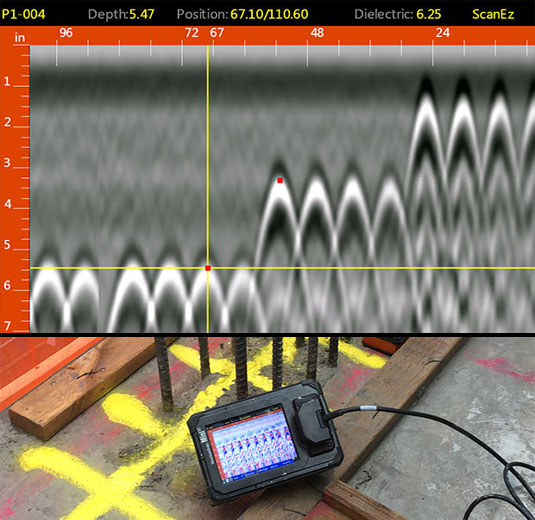Discover RainierGPR Service Areas for Dependable Concrete Scanning Solutions
Enhancing Job Preparation and Implementation With Advanced Concrete Scanning Strategies
In the world of project preparation and implementation, precision and insight are essential aspects that can make the distinction in between success and troubles. Advanced concrete scanning techniques have emerged as an innovative tool established to boost the requirements of job management within the building and construction sector. By using innovative technology, these techniques provide a peek right into the structural stability of a structure also before the first brick is laid. The implications of such advancements are profound, assuring a paradigm change in exactly how jobs are come close to and provided.
Advantages of Advanced Concrete Scanning Techniques

Improved Accuracy in Task Evaluations
Enhancing project evaluations via advanced concrete scanning methods significantly boosts the accuracy and integrity of building and construction evaluations. By employing cutting-edge scanning modern technologies such as ground-penetrating radar (GPR) and 3D imaging, project groups can now get detailed understandings into the condition of concrete frameworks, determining possible imperfections or weaknesses that may not be visible to the nude eye. This enhanced degree of accuracy in project analyses enables construction professionals to make more informed choices regarding repair work and upkeep approaches, bring about enhanced total job outcomes.
Moreover, the increased precision in job assessments accomplished via innovative concrete scanning methods aids in lessening the danger of unexpected concerns during the building stage. By proactively discovering surprise abnormalities within concrete frameworks, such as rebar corrosion or spaces, project teams can deal with these concerns beforehand, preventing expensive hold-ups and remodel later in the job lifecycle. Eventually, the boosted accuracy in project analyses assisted in by advanced concrete scanning methods adds to better efficiency, cost-effectiveness, and top quality in building tasks.
Early Recognition of Architectural Obstacles
Early detection of architectural challenges plays an essential role in making certain the integrity and security of concrete frameworks throughout the construction process. Identifying prospective issues at an onset permits prompt intervention, preventing pricey rework, schedule hold-ups, and security risks. Advanced concrete scanning techniques, such as ground-penetrating radar (GPR) and 3D imaging, enable project groups to discover hidden defects, spaces, support layout inconsistencies, and various other anomalies that can endanger the structure's security.
By implementing these methods throughout the planning and execution phases, building and construction specialists can proactively resolve architectural obstacles before they rise right into major issues. For circumstances, identifying inadequate concrete cover over support bars at an early stage can protect against deterioration and structural weakening in the future - RainierGPR Service Areas. In addition, determining variations in concrete thickness or thickness can assist maximize material use and guarantee consistent toughness properties across the structure

Ultimately, very early recognition of architectural obstacles through sophisticated concrete scanning not only boosts the total high quality and durability Click Here of the building however additionally contributes to a more secure built environment for users and occupants.
Enhanced Safety And Security Measures in Construction
The application of robust safety and security procedures is necessary in the building and construction industry to mitigate threats and secure the well-being of workers and stakeholders. Building and construction sites are inherently unsafe environments, with prospective threats varying from drops and equipment malfunctions to architectural failures. To improve safety and security steps, construction business are significantly embracing technological improvements such as wearable tools that keep track of employees' crucial indicators and detect potential wellness problems in real-time. In addition, making use of drones for website monitoring enables regular safety examinations without putting personnel in injury's way. Security training programs have additionally advanced to consist of virtual fact simulations that give hands-on experience in taking care of emergency scenarios. In addition, the combination of man-made intelligence in security administration systems enables positive recognition of potential threats, permitting timely treatments. By focusing on safety with the consolidation of sophisticated innovations and comprehensive training programs, building projects can substantially lower crashes and produce a protected functioning atmosphere for all entailed - RainierGPR Service Areas.
Streamlining Project Administration Processes
To maximize operational effectiveness and guarantee project success in the building industry, an emphasis on enhancing task monitoring procedures is crucial. By carrying out reliable job monitoring procedures, construction projects can reduce delays, lower costs, and boost general efficiency. One vital aspect of enhancing project management is the usage of innovative modern technologies such as Structure Details Modeling (BIM) software, which makes it possible for real-time collaboration, clash discovery, and accurate job organizing. Furthermore, the adoption of cloud-based task administration platforms enables seamless interaction amongst staff member, immediate access to job information, and the capability to track progress in real-time.

Final Thought
In conclusion, the utilization of advanced concrete scanning methods offers numerous benefits for task planning and implementation. These techniques supply better accuracy in project assessments, very early identification of architectural obstacles, boosted safety and security procedures in building and construction, and structured task administration processes. Integrating these techniques right into task workflows can inevitably lead to a lot more successful and reliable outcomes in construction projects.
Inevitably, the boosted Go Here precision in task analyses promoted by sophisticated concrete scanning methods adds to greater effectiveness, cost-effectiveness, and high quality in building and construction tasks. RainierGPR Service Areas.
To maximize operational effectiveness and make certain task check my reference success in the building and construction industry, an emphasis on improving task administration processes is essential. By applying reliable project administration processes, construction projects can decrease delays, lower expenses, and boost total productivity. By simplifying project monitoring processes through technology combination, clear interaction, and data-driven approaches, building and construction jobs can attain better performance, cost-effectiveness, and successful results.
These techniques give better precision in task analyses, early recognition of architectural difficulties, boosted safety procedures in building, and streamlined task administration procedures.